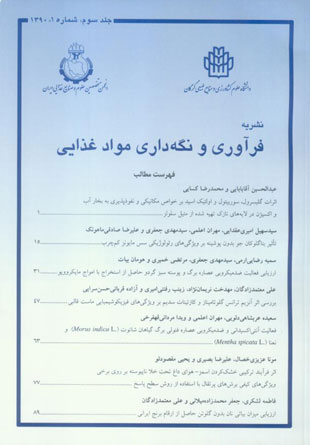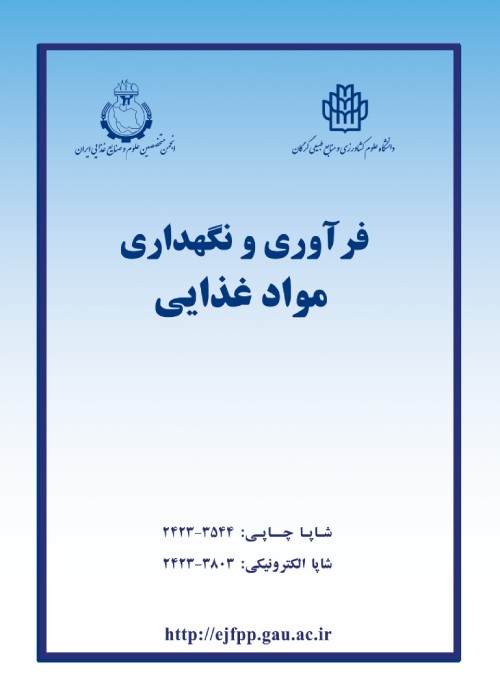فهرست مطالب

نشریه فرآوری و نگهداری مواد غذایی
سال سوم شماره 1 (پیاپی 9، بهار و تابستان 1390)
- 114 صفحه،
- تاریخ انتشار: 1392/05/10
- تعداد عناوین: 7
-
Page 1Cellulose derivatives have very good film-forming properties but their main problem is their poor resistance to water vapor. The effect of individual substances of glycerol, sorbitol and oleic acid and their combined effects on mechanical properties, water vapor and oxygen permeabilities of methylcellulose composite thin films have been studied. Results demonstrated that the above substances yielded in significant changes (P<0.05) on mechanical properties, water vapor and oxygen permeabilities. Oleic acid not only had a plasticizer role but also resulted in reduction in water vapor transmission rate (WVTR) and water vapor permeability (WVP). The reduction rates of WVTR and WVP for the film containing sorbitol were smaller than that of the film containing glycerol. The values of WVP for the composite films [(77% methylcellulose- 7.7% glycerol- 15.4 Oleic acid) and (77% methylcellulose-7.7 % sorbitol- 15.4% oleic acid)] decreased 38.7% and 23.72% in comparison with the films (91% methylcelluose–9%) and (91% methylcelluose – 9% sorbitol), respectively. Similar changes in mechanical properties and oxygen permeability were observed using the above substances in the methylcellulose composite films.Keywords: Methylcellulose, Flexibility, Water Vapor Permeability, mechanical properties
-
Page 15In the present study, effect of hulless barley ß-glucan on rheological properties of low fat mayonnaise was investigated. Mayonnaise fat was partially substituted by ß-glucan at different levels of 20, 30, 40, and 50%, which were referred to as BG20, BG30, BG40, and BG50, respectively. The full fat (FF) (75% oil) mayonnaise without ß-glucan substitution was used as a control experiment. Results of flow behavior showed that all samples were pseudoplastic and also power law model compared with Herschel bulkly showed higher correlation coefficient and thus it can better predict the flow behavior of the samples. In view of time-dependent behavior, all samples showed thixotropic behavior. Due to the results obtained from frequency test, it was revealed that in all samples the storage modulus was higher than loss modulus, which indicates the solid-viscoelastic behavior of the mayonnaises. Furthermore, tangant delta in all samples was less than one that shows higher elastic characteristic in the samples than viscose. It was also revealed that among all mayonnaise samples, the control had the highest tan delta. Finally, since the rheological properties of the control sample were retained even after reduced level of fat and incorporation of the hull-less barley ß–glucan into formulation it can be suggested that the hull-less barley ß–glucan can be used in order to improve the rheological properties of the low fat mayonnaise.Keywords: ß, glucan, low fat mayonnaise, Rheological properties
-
Page 31One of properties of plant extracts is antimicrobial activity. In recent years, numerous studies carried out for finding of preservative and natural antimicrobial material. In this study, antimicrobial activity of extracts of walnut leave and green husk obtained by microwave assisted extraction against staphylococcus aurous, bacillus cereus and Escherichia coli were studied. phenolic compounds in walnut leave and green husk was extracted with methanol 80%, ethanol 50% and water and their antimicrobial activity was evaluated. Total Phenolic contents was determined by Folin ciocaltue assay and was expressed as mg of Gallic acid per gr of dry extract. methanol extract of leave (shahmirzadi variety) with 130.16±0.91 mg/g had highest total phenol content. For study of antimicrobial activity, Minimum Bactericidal concentration (MBC) and Minimum Bactericidal concentration (MBC) contents were used. the results showed that methanolic extract of leaves (shahmirzadi variety) releaved minimum bactericidal concentration (MBC) 625 (μg/ml) against B. cereus. methanolic extract of leaves (shahmirzadi and toyserkani varieties) and ethanolic extract of leave (shahmirzadi variety) revealed Minimum Bactericidal concentration (MBC) 2500 (μg/ml) against S. aurous, methanolic extract of leaves (shahmirzadi and toyserkani varieties) and methanolic extract husk (shahmirzadi variety) and ethanol extract of leave (shahmirzadi variety) revealed minimum bactericidal concentration (MBC) 5000 (μg/ml) against E. coli. Meanwhile water extract of husk did not have bactericidal against E. coli that representing gram negative bacteria were more resistant than gram positive. Hence we can present walnut leaves and husks as a potential source of antimicrobial compounds and after supplementary investigation we may use of them as a preservative in food products.Keywords: Microwave assisted extraction, Antimicrobial activity, Walnut leave, Walnut Green husk
-
Page 47This study evaluated the effect of Transglutaminase activity (0-3 u/g protein), sodium caseinate content (0-0.6%) and enzyme reaction time (60-180 min) on acidity, syneresis, fermentation time and protein cross-linking in set yoghurt using response surface methodology (RSM). Syneresis was analyzed with siphon method. It decreased with an increase in Transglutaminase activity up to 0.6 (u/g protein). Treating with Transglutaminase also induced reductions in monomeric caseins (αs1-, β-, and κ-caseins) contents and formation of high-molecular weight polymers. Acidity did affect by the all treatments used but had not under regular procedure. Fermentation time did not affected by enzyme activity but increased by an increase in sodium casein ate content from 0.6 to 1.2Keywords: Physicochemical, Transglutaminase, Set yoghurt, Acidity
-
Page 63In the present research work, total phenolic content(TPC), antioxidant, and antimicrobial activities of phenolic extracts of mulberry and mint leaves were evaluated. Yield of extraction and TPC of mint leaves extract were higher than those of mulberry leaves extract. TPC of mulberry and mint leaves extracts were 130.5 and 158.7 (mg gallic acid/g dry extract), respectively. The effectiveness of phenolic extracts in inhibiting lipid peroxidation of human erythrocyte membrane was studied. Results showed that the amount of thiobarbituric acid-reactive substances formed by oxidation of membrane lipids were lowered in the presence of both extracts. Moreover, both phenolic extracts would able to enhance the antioxidative capacity of erythrocyte membrane through protecting the reduced glutathione (GSH) against oxidation. Both the extracts were able to inhibit the growth of both G(+) and G(-) bacteria. E. coli and S. aureus were the most sensitive bacteria to mulberry and mint extracts, respectively. Mulberry leaves extract had higher antioxidant and antimicrobial activity than mint extract, in spite of its lower TPC. Both the extracts exhibited dose-dependent antioxidant and antimicrobial activities.Keywords: Mulberry leaves, Mint leaves, Erythrocyte membrane, Reduced glutathione, Antioxidant activity, Antimicrobial activity
-
Page 77Osmotic dehydration is a viable process for the partial removal of water fromplant tissues such as fruits and vegetables. The main advantage of this process is itsinfluence on the principal drying method, shortening of the drying process, resultingin lower energy requirement. Considering that heat is not applied in this stage.Osmotic dehydration offers higher retention of initial food characteristics, such ascolor, aroma, nutritional constituents, and flavor compounds. The effects oftemperature and concentration of osmotic solution 30-55 ºC and 40-60% (w/w),respectively, Contact time 120-300 min and by applying vacuum pulse (100-300mbar for 10 min) at the beginning of the process (pulsed vacuum osmoticdehydration, PVOD) and Drying temperature (40-70 ºC) on color changes and WL(water loss) to SG (solid gain) ratio of orange slices were studied. The optimizationof combined process was done by Response surface methodology with Centralcomposite design. The analysis of variance showed that a linear model predicted wellthe experimental data. The applied temperature of osmotic solution and dryingtemperature had the main effect on responses. Optimization conditions were basedon the higher water loss to solid gain ratio and lower changes of color. Optimalconditions were 35 ºC for osmotic temperature, 60% for sucrose concentration, 180min for osmotic time, 240 mbar for pressure and 41.5 ºC for drying temperature.Keywords: Osmotic dehydration, Optimization, Response surface methodology, Vacuum pulse, Orange slices
-
Page 89Staling of the bread prepared from the flour of various kinds of newly developed rice cultivars (Tarom, Shiroodi, Neda, Fajr, Ghaem and Binam) was investigated. For this purpose, six cultivars of Iranian rice flour with 2% hydroxypropylmethylcellulose (HPMC) added as gluten substitute were studied with storage. Moisture content, enthalpy changes (ΔH) and firmness of bread were monitored and found to be significantly affected during storage at room temperature. Crumb moisture content was found to decrease steadily during staling and crust moisture content increase in storage time. Enthalpy changes (ΔH) as measured by differential scanning colorimeter (DSC) increased in storage time in Binam, Fajr, Tarom, Shiroodi and Neda cultivars. Ghaem, Binam and Tarom cultivars had low amylose content and they had low values of ΔH. Staling of gluten-free rice bread results in increasing firmness of crumb and decrease firmness of crust. So the crumb texture of this bread became progressively harder with storage. The lowest value of crumb firmness was reported for Binam cultivars in four days of storage.Keywords: Cultivar, Enthalpy, Gluten, free bread, Rice, Staling


